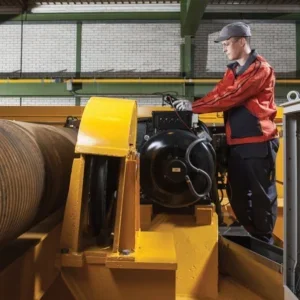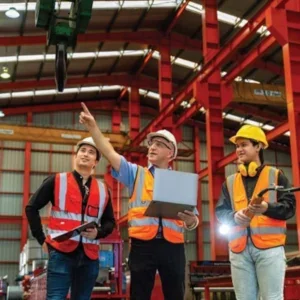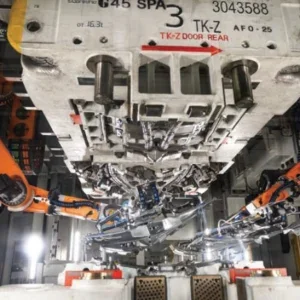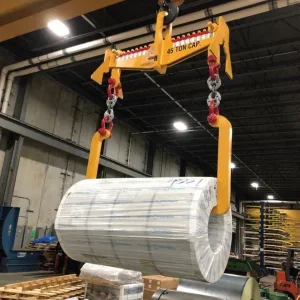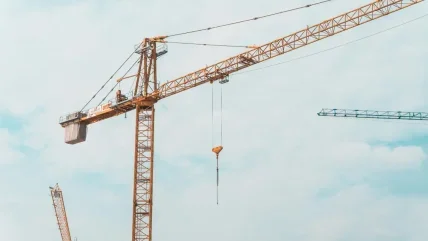
Look up ‘Industry 4.0’ on Hoistmagazine.co.uk and you’ll see search results dating as far back as 2014, while the term itself has been around for more than a decade.
Back in 2014, Industry 4.0 – or the Fourth Industrial Revolution, the comprehensive digitalisation of industrial production – was described on the Hoist website as being a “new manufacturing paradigm that is more customisable, flexible and productive than everything that has gone before it”.
That might sound like hyperbole to some – especially when the mechanisation of the Industrial Revolution (18th to 19th centuries), the electrification of the Second Industrial Revolution (19th to 20 centuries), and digitisation of the Third Industrial Revolution (20th century onwards) are the monumental eras that precede and in the latter instance overlap with it – but Industry 4.0 continues to promise much.
This, for example, is what Mitsubishi Electric, which makes variable frequency drives for cranes, says of Industry 4.0 in a blog from a few years ago: “One area where Industry 4.0 technologies can be put to much-needed use is in crane operations in material handling environments. Whether you’re running gantry cranes, suspension cranes, bridge girder cranes, or rotary cranes, today’s advanced solutions can help you improve and optimise performance and efficiency, streamline processes, lower operating costs, reduce equipment wear and tear, keep teams productive, and more.
“By connecting all of your cranes and other machines and applications into a single smart system, you’re able to increase business agility. Material handling organisations that fully embrace Industry 4.0 and put its technologies to use in their crane operations can develop new capabilities. They can also gather and analyse data from a range of sources to gain valuable insights into processes which lead to more informed decision-making and improved outcomes.”
And then there’s this, from crane manufacturer Konecranes’ website: “The heart of the Industrial Internet [Konecranes’ name for Industry 4.0] is based on a series of sensors working together to gather and analyse data. By operating in this way, they can enable efficiencies that were unimaginable just a short time ago.
“The Industrial Internet will bring greater speed and efficiency to a variety of industries, such as aviation, rail transport, power, oil, gas and healthcare. It even holds the promise of stronger economic growth, more and better-quality jobs, and improved living standards, regardless of geographical location.
“Linking intelligent devices, facilities, fleets and networks with people at work and on the move opens up new possibilities for process optimisation and the potential to increase productivity and efficiency.”
And yet, despite the advantages outlined above, not everyone’s scrambling to get onboard the Industry 4.0 technology train.
Last year, Siemens, which produces the Simocrane crane automation system, brought together over 2,000 industry, governmental and economic thought leaders at its inaugural Transform event, where it collected views on progress towards digital transformation in industry. In the subsequent paper, ‘The Digital Transformation Imperative’, Stephen Phipson, the chief executive of the manufacturers’ lobby group Make UK, highlights that there is an adoption problem: “The challenge isn’t so much the technology, it’s getting companies to make the adoption leap, to have management curiosity and try it in their factories. This is particularly a hurdle for SMEs.”
The general manager for motion control at Siemens UK&I, Sarah Black-Smith agrees. “Having leadership onboard and the ability to grasp concepts and make changes is as important as having the right technology in place,” she says.
Those who don’t take advantages of the benefits of Industry 4.0, face possible consequences, warns, Vita Inclinata. The company, which produces crane load stabilisation hardware, says in a blog: “Operators who continue to believe that ‘how I do it has always worked’ risk being left behind by a changing industry. As work sites become more connected, insurance companies mandate new technologies, and governments update regulations, crane operators will be pressured to modernise.
“It is imperative that business leaders, contractors, and operators start evaluating new technologies and have a plan to stay a step ahead of the changes that are about to redefine the industry.”
COVID-19
For all the negative impacts of Covid on business, the pandemic had a positive impact on Industry 4.0.
The Siemens paper quotes the ‘Manufacturing Digital Productivity Report’ from iBASEt – which provides manufacturing software solutions – that was supported by the Manufacturing Technology Centre (MTC) research organisation. This paper suggested that “many manufacturing organisations (67%) implemented Industry 4.0 and smart factory technologies in response to the pandemic and social distancing rules, with 30% doing so for the first time”. More than two-thirds (68%) said this made them more productive, and more than half (51%) said it made their business more agile.
Carl Ennis, CEO of Siemens UK & Ireland, adds: “The significant impact of Covid-19 on… industries, coupled with additional energy and inflationary pressures at the fore, have accelerated rapid transformation” and that “digital technologies and platforms are playing a crucial role in enabling this transformation.”
Ennis continues: “Over 70% of [UK] firms say that new technologies have improved business resilience, according to [business lobby organisation] the Confederation of British Industry. The same is true in Ireland. In short, whether addressing workforce challenges including Covid-19, skills shortages, decarbonisation, supply chain issues borne of geopolitical disruption or material shortages, organisational transformation will be digital.”
Meanwhile, a 2020 report by McKinsey, the management consultants, shows that Industry 4.0 helped 94% of respondents to keep operations running during the Covid crisis, while 56% said these technologies had been critical to their crisis responses. The report also includes evidence that echoes and backs up Vita Inclinata’s warning for businesses that do not adopt Industry 4.0: “Companies that had not implemented Industry 4.0 prior to Covid-19 have had a wake-up call,” the McKinsey report states. “Not only did they find themselves struggling during Covid-19, but also the absence of past experience, lagging underlying IT/OT [information technology/operational technology] technology stacks, and Covid-19-driven cash constraints are making it difficult for them to catch up.”
The opposite, of course, is also true, for companies that do adopt Industry 4.0.
“Companies that embrace Industry 4.0 technologies – such as networked systems, IoT [Internet of Things], cloud technology, data analytics, human-machine interaction, and AI – set themselves up for great rewards,” says Mitsubishi Electric. The McKinsey reports presents proof of that success: “The benefits these companies have recorded include 30-50% reductions of machine downtime, 15-30% improvements in labour productivity, 10- 30% increases in throughput, and 10-20% decreases in the cost of quality.”
PREDICTIVE MAINTENANCE
One particular advantage of Industry 4.0 is its ability to deliver predictive maintenance.
Stahl CraneSystems describes it as “one of the cornerstones of Industry 4.0”.
“It differs from reactive maintenance, where faults are only repaired after they have occurred, and preventive maintenance, which replaces parts that are possibly still working well at fixed intervals as a precaution,” Stahl explains. “In predictive maintenance, the wear of individual parts can be calculated better with the help of the data collected on a system. This means that failures can be prevented with selective maintenance measures.”
Mitsubishi Electric, meanwhile, calls it an “important benefit”. “When cranes and other machinery are connected to back-office systems and AI applications, you get full visibility into each link in the value chain. As cranes begin to wear, smart systems can alert you to potential issues before they escalate and cause unexpected downtime or a safety incident.”
A further benefit of Industry 4.0, Mitsubishi Electric, says in its blog, is that not only are those that embrace Industry 4.0 keeping their organisation competitive and setting themselves up for success today, but they’re “also preparing for Industry 5.0, which is just beginning to emerge now. It’s the next exciting step in the digital transformation journey, and it focuses on human interaction with that smart, connected system from Industry 4.0. Early adopters are already moving ahead.”
Yes, you heard that right – some organisations are already thinking of Industry 5.0, which means that those companies that have yet to even investigate Industry 4.0 are in danger of being left even further behind.
Industry 4.0 is all about the digital transformation of manufacturing and production processes. It leverages technologies such as automation, artificial intelligence (AI), Internet of Things (IoT) and the Industrial Internet of Things (IIoT), cloud and edge computing, and big data. With those technologies, manufacturers can create ‘smart’ factories and warehouses, where equipment and systems are connected and communicating. Industry 4.0 is enabling levels of customisation and automation – as well as efficiency and productivity – that weren’t even possible before.
Mitsubishi Electric
The term ‘Industry 4.0’ describes the intertwining of industrial production with information and communication technologies, resulting in intelligent value chains.
Stahl CraneSystems
The heart of the Industrial Internet [Konecranes’ name for Industry 4.0] is based on a series of sensors working together to gather and analyse data for specific purposes. The Industrial Internet refers to the integration of machines with networked sensors and software. It not only involves a comprehensive transformation of global industry, but also affects many aspects of daily life, including the way many of us do our jobs. In addition, it will alter the competitive balance and force the rest of industry to rapidly adjust if it wants to survive. The pace of this process will vary from industry to industry, but the effects will be experienced more broadly across the economy as adoption increases.
Konecranes
Industry 4.0 means the comprehensive digitalisation of industrial production. Man, machine, systems and logistics – everything networked, including the life cycles of products, from the cradle to the grave. There is currently no end in sight to digital developments.
Liebherr
The term Industry 4.0, or Fourth Industrial Revolution, is shorthand for the coming evolution in the industrial sector and is based on the idea that machines should be able to communicate with each other and provide insights, capabilities, and efficiencies. These are not just ideas, Industry 4.0 systems and technologies are already reinventing how we live and work. Amazon, for instance, employs advanced data tracking systems across its entire supply chain to optimise efficiency in real time. In the industrial sector, Volvo has… deployed a predictive analytics platform to monitor its fleet of trucks, resulting in a 70% reduction in diagnostic time. While these are just two examples among thousands, the bottom line is this: the technology associated with Industry 4.0 has transformed business operations, logistics and manufacturing. And it is now transforming construction.


